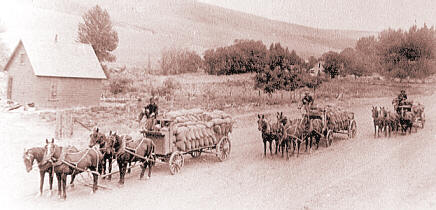
Grain wagons on the road.
Courtesy of the Garfield County Museum.
Introduction
Most of us who live in the Pacific Northwest take agriculture, and particularly, grain production for granted. To us, the rolling fields of wheat and barley are a natural part of our lives. Spring brings the wheel tractors out into the field and we see the planting of each new crop as an essential part of the turning of the seasons. In the fall, the golden fields and lumbering combines are customary parts of our lives. But think for a moment, about what the Pacific Northwest was like before the European settlers changed our landscapes.
The exploration and settlement of the Pacific Northwest was a gradual movement, from wandering fur trappers and prospectors, towards settled homesteads and farms. This rich land drew the itinerant farmers of the east coast, the new emigrants of Europe, and the frustrated miners of the west. Those who eventually settled in the Southeast corner of what would become Washington state, found the rich soil that allowed them to produce an abundant supply of grain. To profit from the harvest the farmers must be able to transport their grain to market. Markets within southeast Washington grew along rivers, or at existing rail lines. Walla Walla, whose rail line was completed in 1875, and Dayton, in 1880, were main shipping points.1 Portland was, and remains, the main sea port for Oregon and Washington.
Towns grew slowly as population increased. But there are still areas within southeast Washington that remain sparsely populated with few towns. Garfield county, which is located at the southeast corner of Washington state, "is one of the few places in America where fewer people dwell today than before Columbus sailed from Spain. Like much of the West, the lower Snake River country, meagerly populated but productive, has always been a land of export."2
For the early farmers transportation to market meant horse and wagon. Grain transport by wagon from Pomeroy to Dayton, the nearest rail head, took two days one way. Hauling grain down into the Snake River canyon, to be picked up by steamboats, was an option for those farmers near the river.

Hauling down the grade (Ilia).
Courtesy of Washington State University Archives.
But hauling grain down into the Snake River Canyon was not an easy proposition. Typically, four to six horses pulled two wagons hitched together and loaded with two and one half tons of grain down the narrow and winding switch-back grades. Because of the many switch backs in these grade roads this process took one day for a round trip. In the process you risked your life and that of your horses. Due to these obstacles the local farmers began a series of innovative schemes that would solve their transportation problems for several decades along the Snake River gorge.
Farmers built grain "chutes" and "tramways" using gravity to move their grain from the flat river bluff tops to the banks of the river bed. The evolution of the transportation systems from the primitive grain chutes to the complex tramways was a direct outgrowth of the ingenuity of these early farming pioneers. Their growth was an answer to the rugged landscape in which the farmers found themselves.
Eventually, the farmers abandoned the grain tramways. After the introduction of combustion engines farms converted to bulk grain handling. The shift from horse powered farming to gas powered farming was an inevitable offspring of the industrialization of America. Additionally, the drain on the labor pool caused by the beginning of World War II forced farmers to find new ways of running all the farming operations with fewer men. The switch from sack grain handling to bulk grain handling was an answer to the labor shortage. The movement toward mechanization of the farming operation, and the adoption of bulk handling methods, led to the death of the tramways, themselves a labor saving innovation.
1. Oscar Osburn Winther. The Old Oregon Country; A History of Frontier Trade, Transportation, and Travel, (Stanford, CA: Stanford University Press, 1950), 293-294.
2. Keith Petersen. River of Life: Channel of Death; Fish and Dams on the Lower Snake, (Lewiston, ID: Confluence Press, 1995), 17.
Introduction
Geography
• Farming
• Transportation
• Grain Chutes
• Mayview Tramway
Bulk Handling
• Conclusion
• Bibliography
• Oral Interviews
• Maps
• Illustrations
Acknowledgements
• Comments
![]()